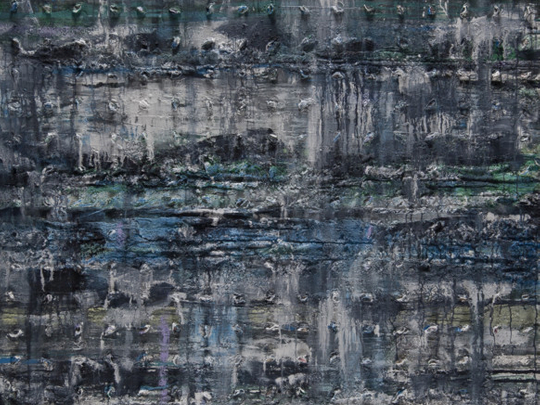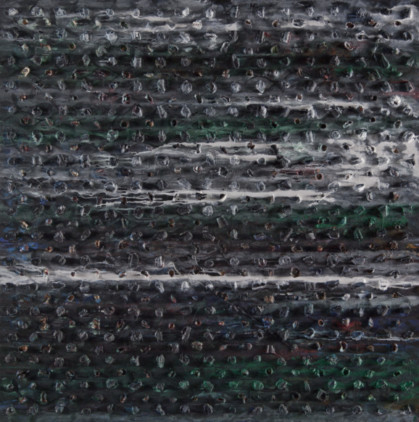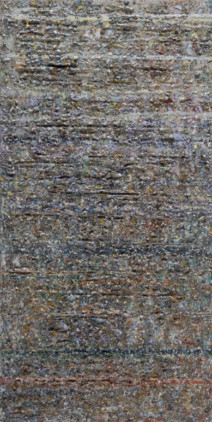
In recent years, UAE-based Syrian artist Thaier Helal has appropriated media images of Syrian soldiers and weapons to create haunting mixed media works that speak about the tragic situation in his country and the increasing militarisation of global society. But he sees no point anymore in talking about the mindless violence and political or economic agendas.
In his latest exhibition, “Landmarks”, Helal returns to abstraction and to his memories of the rugged and beautiful Syrian landscape. The show features neo-expressionist paintings from his “Mountain” and “River” series, which capture the beauty and power of nature and draw hope from its potential for regeneration.
“The situation in my country is so hopeless that I do not know what to do or say anymore. I just needed to paint something that is positive and offers hope — something that reminds us of our history, our culture and our old way of life. So I am painting the rock and the water because the rock is hard, strong and resistant, and the water is tranquil, fluid and able to change direction. Both these elements offer us inspiration in these sad times to remain strong and to find a new direction. I want to convey that despite the terrible reality of today, there is still hope for a better future,” Helal says.
In the “Mountain” series the artist has used acrylic paint, sand, paper and other materials to create textures that evoke the rough terrain and dramatic rock formations around his hometown Maaloula, in the Qalamoun Mountain area to the northeast of Damascus. This ancient Christian town is the last remaining place where Western Aramaic is still spoken because its location in the rugged mountains allowed this linguistic tradition to survive the rise and fall of various civilisations over hundreds of years.
But earlier this year the town was attacked, its famous monastery was destroyed and many inhabitants were driven out. Helal’s paintings of the area in different seasons and in different lights lovingly recreate his childhood memories of the place, and reaffirm his faith in the enduring power of nature. “I want to remind people that we also have a history that is good. In Maaloula the Aramaic language was preserved and people of different religions lived together harmoniously for centuries. We have to take inspiration from this legacy and learn from it to make our lives better, stronger and more beautiful,” Helal says.
In the “River” series, the artist has used stones, leaves, flowers, twigs, pine cones and other materials usually found floating in the water to create paintings that evoke the movement and energy of a flowing river and reflect the life within the river and around it. Here, he has chosen to depict the Al Asi River, also known as the Rebel River, because unlike the other rivers in the region it flows from south to north. The river’s unusual flow expresses Helal’s belief that there are many alternative ways to live one’s life and many different paths that a society can choose.
“I have been living in the UAE since the 1990s, but in the last three years my heart and mind have been in Syria. I feel schizophrenic and that duality is reflected in my work. The rocks of these mountains are strong, tough and permanent. The river is also strong, but it is so fluid, changeable and ephemeral. The strokes of red in my paintings of the rugged mountains reflect the fires and bloodshed in the area, but also symbolise strength and endurance.
Similarly, the floating objects in the “River” series refer to the desperate Syrian refugees who have lost their lives while attempting to get out in boats. But they also speak about the life sustained by the river. I have tried to depict the good and the bad, sadness and happiness, despair and hope,” Helal says.
In his signature style, the background in the paintings is covered with repetitive grids and patterns inspired by Islamic artistic traditions. “These grids composed of stones, flowers and leaves are like an infinite heartbeat. They suggest that nature is all powerful and in the end that is what will remain, not war,” Helal says.
Jyoti Kalsi is an arts enthusiast based in Dubai
‘Landmarks’ will run at Ayyam Gallery Dubai, DIFC until January 10, 2015.
Artists with special needs involved in setting a new Guinness record
Dubai has entered the Guinness Book of Records once again for creating the “largest abaya” in the world. The abaya, which is 10 metres long and over four metres wide, has been designed by Dubai based fashion company Future Fashion in collaboration with the talented artists from Mawaheb from Beautiful People, an art studio for adults with special needs.
“It was my idea to make the largest abaya in the world, and all our artists were involved in creating the abstract paintings that were then printed on the garment. We are grateful to Jackie Bhagnani of KunalTex Trading for donating the fabric, and to artist Shefali Ranthe, who guided our artists in creating paintings based on the theme ‘An imagination of Colours’,” Gulshan Kavarana, art teacher at Mawaheb says.
The abaya was displayed in public in the Al Fahidi Historical Neighbourhood during the Sikka Fair in March. But later, the Mawaheb artists further embellished it with a hand painted panel of colourful, abstract patterns. The wait for recognition of their achievement was over on December 14, when the certificate from Guinness was officially awarded in a ceremony held at the Ivory Grand Hotel, Al Barsha in the presence of Khalil Abdulwahid and Jasem Albaloshi, head of visual arts and heritage executive respectively at Dubai Culture & Arts Authority. The project was sponsored by Art Season, Mawaheb, Future Fashion, Juton, Mermaid Digital Printing and KunalTex Trading.
“Through our exhibitions at prestigious galleries in Dubai and participation in various creative events like this we are showing the community that people with special needs have incredible talent and ability and they are full-fledged participants in society,” Wemmy de Maaker, founder of Mawaheb says.













